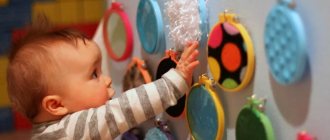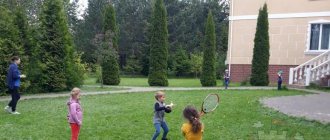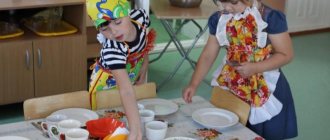Organization and holding of the “Game Hour” in a preschool educational institution
XIII Pedagogical Conference
“Innovative experience is the basis of systemic changes”
Topic: Organization and holding of the “Game Hour”
at preschool educational institution
Kozlova Elena Alexandrovna
Relevance:
The Federal State Educational Standard for Preschool Education notes that a preschool child develops in specific types of activities and, above all, in play. In the modern world, the word “game” is associated with something frivolous and entertaining. But this is not so, in the game there is a comprehensive development of the individual: the cognitive activity of children increases, speech, memory, thinking, attention, fine and gross motor skills develop.
Problem:
When a child comes to a group, he starts a game, he is interested, he is carried away, but at the very peak of the game it is time for breakfast, then comes GCD, various rehearsals for some events, then a walk, sleep - time has passed, but the game did not take place . What is the problem, why do children not have the opportunity to play for fun? In my opinion, the problem is that there is not enough time in the schedule for free play activities for children.
Having analyzed the state of play activity of the pupils, I saw that the development of play skills in the children of my group does not reach a high level.
During the distribution of roles, conflicts occurred, role behavior was not observed throughout the entire game, and rules could be broken.
A survey of parents on this issue showed that play is present in children’s lives, but is no longer of paramount importance. Parents know about the importance of games for a child, they play games with their children from their childhood (hide and seek, forfeits, corners, rubber band), but they note that in their free time the child just walks, if there are brothers and sisters, he plays with them. According to parents, the most important things for a child are playing sports, attending clubs and classes to prepare for school, and computer games and watching television programs have become children’s favorite activities.
Considering that the game fulfills its developmental functions when it is not organized by the teacher from beginning to end, but is an independent activity of the children, the idea arose to organize a “Game Hour” in the group.
The purpose of my work was:
creating optimal conditions for gaming activities and consolidating gaming skills that ensure the development of initiative and independence in preschoolers.
To achieve this goal, the following tasks were identified:
- develop the ability to transfer impressions from the surrounding life into game situations;
- consolidate the ability to transform space in accordance with the plan, distribute roles, act in accordance with the role;
directly in the bedroom and group room during the cold season and on the site during the warm season.
Group classes are slightly longer in duration than a physical education lesson (up to 25–30 minutes for younger preschoolers and up to 35–40 minutes for older preschoolers). For younger children, exercises and movements should be associated with play and demonstration; for older children, the word predominates or the word is combined with demonstration. The recommended structure of a recreational play hour for preschool children is presented in Table.
1. Table 1
Structure of a recreational play hour
The most universal and effective form of training session. It does not always look like a traditional lesson, but the main components of the lesson (preparatory, main and final parts) must be present in any form of lesson organization.
The purpose of the warm-up is to ensure the gradual preparation of the child’s functional systems for more intense loads. During the warm-up period, it is necessary to most carefully prepare those muscle groups that will be most involved in the main part of the lesson. Typically, warm-up involves walking at different tempos, running, simulated jumps, etc. Warm-up exercises involving various muscle groups (1–2 min), breathing exercises (2–3 min).
The main part of the lesson is devoted to the development of physical qualities or learning movements by performing gymnastic exercises with various objects in a game or relay mode (12–15 minutes) and active role-playing games (12–15 minutes). The most complex movements are learned at the beginning of the main part of the lesson, and it is better to develop and improve physical qualities in the following sequence: exercises for coordination, speed, strength, endurance. The duration of the main part is from 20-2 5 minutes for younger preschoolers, to 25-30 minutes for older ones.
In the final part of the lesson - calm walking, relaxation exercises, light jogging, breathing exercises (2-3 minutes). The lesson is carried out with children dressed in lightweight sportswear (initially in a T-shirt and panties, then only in panties), barefoot, in a well-ventilated room with an air temperature of 16 to 20°, with a gradual decrease depending on the physical activity of the children up to 12 °. The temperature regime of the recreational play hour when combined with a pulsating microclimate is described in detail in the methodological manual for hardening children.
On the days of the recreational game hour, a physical education lesson cannot be excluded. They somewhat reduce the motor play load and pay special attention to special hardening procedures (wet rubdowns, contrasting foot baths, etc.).
The modern concept of organizing physical education in kindergarten involves the use of outdoor games as the main component of planned physical education classes, which are part of the “Education Program in Kindergarten.” Children learn life by playing.
It is in games that they enter into different, sometimes complex relationships with their peers, showing dexterity, courage, and intelligence.
For children, everything around is a fun, joyful and exciting game. If they like it, they are ready to play the same game many times in a row. For preschoolers, all physical education classes that the teacher conducts come down to play.
Gameplay in preschool educational institutions should be focused on compliance with the requirements in which games must:
• influence the psychophysiological development of children;
• develop motor skills;
• organize children for collective action;
• easy to digest for children;
• whenever possible, carried out in the fresh air;
• easy for teachers to use for working with children;
• do not require special devices and benefits. For the first time, the idea of the need to give additional game actions a daily routine character was put forward by Yu.F. Zmanovsky. In addition to the 10-15 minute game, he introduced a warm-up, a physical education part (gymnastic exercises of various types) and a final part, in which he attached great importance to breathing exercises.
Then it was proposed to combine air baths with games: children played semi-naked games - first in open T-shirts, panties, socks and slippers, and later - only in panties and slippers. The dosage of air baths ranged from 7 to 28 minutes and was closely related to temperature conditions and the intensity of physical stress. the use of physical exercises in the form of outdoor games and hardening procedures began to be combined
their main provisions were developed:
• outdoor games and exercises should involve a large group of muscles at the same time. This corresponds to movements such as walking, running, jumping, throwing, and climbing. Less acceptable are movements involving a limited number of muscles: head turns, lateral bends of the body, shoulder movements, etc.;
• it is desirable to exercise in which all children are involved at once, and not one by one;
• exercises should be accessible and simple, not require lengthy preparation and a lot of attention. Tasks should be given that children can immediately complete after being shown by the teacher or that are already familiar to them;
• it is important to arouse children’s interest in these activities and create a desire to harden themselves;
• during classes, those tasks that the child performs with joy, without suspecting that he is obeying the wishes of adults, are valued;
• hardening activities related to movement can be used in kindergarten throughout the year in various types of classes.
We are convinced that games are preferable to regular gymnastic exercises. Organized outdoor games develop children's strength, speed, endurance, flexibility, and dexterity. They are the basis for the harmonious development of a child. The value of collective games lies in the fact that they represent the first stage of collective communication between children and help develop the child’s independence, his creative imagination and fantasy. Another advantage of the game is that children who, for health reasons, belong to different groups (according to permitted physical activity) can participate in it. The game allows individual load dosing.
Outdoor games are one of the best methods of air hardening, the conditions for which are created in indoor classes, if the basic requirements for the preparation and content of physical education and game classes are met.
The longer the game, the longer the same set of exercises is worked on, the more pleasure the children take part in them. Frequently changing games is not advisable; it is better to complicate already familiar ones, increasing the distances that need to be overcome, changing the rules of the game, which require greater accuracy in completing tasks.
Children for whom the movements used in the game do not present any difficulties are usually active and cheerful. If during the game a child fails to pass, run or throw an object, his emotional tone decreases, he ceases to rejoice, and becomes passive. The teacher should pay attention to such children, try to ensure that they make all possible movements and become active.
You should not praise some children and emphasize the awkwardness and sluggishness of others. We must remember about individual typological characteristics: children who lag behind their peers feel inferior, gradually give up classes, and become sedentary.
Games with children should be held daily. Not a single day should pass without games and gymnastic exercises, into which special hardening procedures should be woven as a natural element.
Text of the book “Formation of children’s health in preschool institutions”
Recommendations for organizing meals
Diet. A healthy child always has a good, steady appetite. There is even such an everyday aphorism: “A child does not eat in two cases: when he is full or when he is sick.” Therefore, under no circumstances should you force-feed a child - this may cause him to have an aversion to food.
You should not overfeed children, because overeating leads to undesirable consequences - digestive disorders, obesity, etc. It is not physiological to give supplements to children for whom this is contraindicated due to their health conditions. If the supplement is given to children with a good appetite in the absence of contraindications, then in an amount of no more than 50 g of soup or side dish.
The normal development of appetite is facilitated by strict adherence to the daily routine and feeding regimen, which should be carried out not only at the same time, but also for a certain duration (breakfast, afternoon snack and dinner - 15 minutes each, lunch - 30 minutes).
In order for the appetite to fully manifest itself, the food must be familiar to the child - the appetite does not develop for unknown food, it must be accustomed to it gradually. Therefore, one of the conditions for organizing catering in a preschool educational institution is the cyclical nature of the menu, with individual dishes occasionally replaced, but not all at once.
Nutrition culture includes rules for the appearance of dishes, table setting, and child behavior at the table, since children are emotional, and negative emotions reduce appetite.
The ability to deliciously prepare and beautifully serve baby food requires great skill from the cook. Unlike adult cooking, spices, seasonings, herbs, etc. are unacceptable here. The good taste of children's food is achieved by a maximum variety of dishes and products, proper menu design, and the use of a variety of vegetable salads, appetizers, lactic acid seasonings and sauces, and fruit vinegar.
Food beautifully and neatly laid out on a plate stimulates the child’s appetite, attracts his attention, and enhances the secretion of digestive juices. It has been noted that “a child eats with his eyes,” which is why the color of food is so important: he accepts colorless dishes without pleasure.
…
For example, a combination of dishes such as pickle and pasta with meat in lunch does not raise objections from a nutritional point of view, but such a lunch will not seem interesting to the child. It is worth replacing the pickle with pink beetroot or borscht seasoned with herbs (onion, parsley), and adding a couple of black plums and a sprig of lettuce or spinach to the pasta, and lunch will become more attractive.
In addition to the external design, the temperature of the food served is important. Children should receive fresh food (temperature 50–60°). Very hot and cold foods slow down digestion and can cause burns or colds. The temperature of food should be adjusted depending on the time of year and ambient temperature. So, in summer, beetroot soups, potato and cereal soups with vegetable or fruit infusions are best served chilled, and in winter, all dishes are served warm. The same applies to third courses.
The issue of aesthetics of food served to the table is inextricably linked with bright, beautiful, age-appropriate cutlery, dishes and other accessories that can attract the child’s attention.
We recommend special sets of dishes and cutlery designed for children under 7 years of age, as well as some cutlery that is not often seen (thermos plates with double bottoms for children who eat slowly, cutlery decorated with figurines of animals and birds, etc. .). The use of aluminum appliances is prohibited. Aluminum
–
enemy of calcium and phosphorus.
This highly active element easily forms chemical compounds with other substances.
Aluminum ions can replace calcium ions, which are the building material for bones, and thereby cause serious changes in calcium metabolism, including demineralization of bone tissue. According to the latest data from scientists, aluminum enhances the removal of zinc from the body, which leads to the development of dementia.
The aesthetics of table setting involves thoughtful, careful placement of food on the plate. You need to try not to fill the edges of the plate, cut the bread thinly, spread it with butter or jam so that the child does not get his hands dirty. You should not serve too full plates, so as not to scare the child with the amount of food to be eaten.
The child should sit comfortably at the table so that the table and chair correspond to his height. He should have his feet on the floor and could lean against the backrest with support for his arms.
From 3–4 years old, a child is taught to use a fork, from 6–7 years old – a knife.
Children should be taught a certain place at the table, cleanliness, neatness, and instill in them sanitary and hygienic skills - washing their hands before eating, and, if necessary, after eating, using a napkin, etc. This is facilitated by children’s self-service duties. It’s good when children sit down at a pre-set, served table.
It is necessary to ensure that the child does not put too much food into his mouth, does not swallow too large pieces, chews the food thoroughly, but also does not delay the eating process.
Children should eat their assigned portion of the first course. We must ensure that they eat the main contents of the second course, alternating with a side dish, and learn to eat fruits and berries from compote together with liquid, and not separately.
The child should eat not too tired and in a good mood. Therefore, both before and during meals, you should not disturb him with unpleasant conversations, painful procedures, temperature measurements, and in no case with shouting and punishment. Walks should end 20–30 minutes before meals, as should vigorous, lively games.
During meals, you should not share with your child too strong impressions that can have a stimulating effect on his nervous system. During meals, you should not give your child gifts, books or toys or distract his attention with strangers coming and going.
Before eating, you need to create a calm mood in the child, arouse his interest in the dishes being served, introducing him to the table setting, reminding him of hand washing and the delicious food awaiting him.
Taken together, all of the above forms the cultural skills and nutritional culture of children, ensures their health and proper development.
MOTOR MODE OF CHILDREN IN PRESCHOOL EDUCATIONAL INSTITUTIONS
Wellness and gaming hour
Movement is one of the universal manifestations of human life. Movement is the main function of a small child; through movement, he learns about the world, improves the motor apparatus, regulates metabolic processes, on the mutual harmony of which growth and his physical development depend.
Doctors' observations suggest that mobility is characteristic of healthy children, and inactivity is, as a rule, characteristic of those suffering from some kind of illness. Unfortunately, without knowing this, children are often forced to behave calmly and sit in one place for a long time, which delays their physical and mental development. “Function creates organ” is a biological law that everyone should know.
Skeletal muscle exercise provides the energy needed to maintain body temperature and a high metabolic rate. The higher the activity of skeletal muscles, the more harmonious the exchange, the more complete the function of organs and systems. Moderate but systematic muscle activity hardens the body, increases its resistance to harmful factors and infections, and has a beneficial effect on the regulation of physical and chemical processes in tissues.
Movement is a means of harmonious personal development. This is not only the path to health, but also to the development of intelligence. Movement, especially of the fingers, stimulates the development and activity of the brain and its various parts. Properly organized physical education contributes to the development of logical thinking, memory, initiative, imagination, and independence in children. Children become more attentive and observant, more disciplined. Their will is strengthened and character is developed.
The development of motor skills and their quality have a significant range and depend not only on the individual typological characteristics of the child (genetic properties), but also on the conditions of upbringing, on the correct regime of sleep, wakefulness, nutrition, and gymnastics.
A young child is characterized by a tendency to intensify the processes of excitation and inhibition. Optimal excitability of the brain, which contributes to the normal course of physiological processes, largely depends on the development of the motor analyzer, on its perfection, and on motor activity. A special role in maintaining optimal excitability of the cerebral cortex is played by a positive emotional tone (joyful state), which is best realized in the game.
Playful activities in combination with contrasting air baths and additional physical activity on the playground form the basis of the health-improving techniques proposed by N.D. Gorelik, Yu.F. Zmanovsky, B.S. Godun and others. The authors note the good health-improving effect of such activities, which is manifested in reducing the incidence of children, improving their neuropsychic state, physical development, and physical fitness. Research data show that improving the conditions of physical education in preschool educational institutions makes it possible to reduce the incidence of ARVI by 2 times, ease its course in those who are sick, and reduce the number of musculoskeletal disorders by 1.5 times.
…
The basis of traditional methods of physical education in preschool institutions is the scheme for the formation of motor skills, laid down in the first third of the 20th century (the teachings of I.P. Pavlov). An adult demonstrates a movement; children reproduce it many times, a dynamic stereotype (skill) is formed with the transfer of the learned pattern to new situations and its final consolidation. A positive result is a firmly acquired motor skill. Culture as an element of “physical culture” is present in the traditional theory and practice of physical education of children nominally. The value guideline of traditional physical education in preschool educational institutions has been and remains the normative ways of organizing physical activity adopted in it. Pedagogical work is actually replaced by coaching, which is carried out more or less successfully by a physical education instructor, although the qualifications of a teacher-instructor are more necessary. As an alternative to such sports education, outdoor games have been proposed and entered into the practice of preschool education, but they often turn into a way of motor training for children.
By focusing its efforts on motor training, traditional practice essentially removes the task of animating movements, developing motor imagination, which represents projects for future movements that the child will have to implement in new, non-standard situations.
In such cases, role-playing game is useful, which periodically interrupts the motor activity of children. In it, children are faced with the need to quickly rebuild images or create new ones. The image carries within itself a specific code of that holistic psychosomatic state that should accompany the construction and creative execution of any movement. The child’s free construction of a motor image contributes to the development of his motor skills. The teacher’s task is to select these images in the proposed game.
On the days of scheduled physical education classes, movement accounts for about 10% of the child’s active state; 22–25% of the time is occupied by outdoor games during walks, another 10–15% is given by active movements, morning hygienic exercises, labor processes, etc., determining, together with the above-mentioned routine moments, about 45–50% of the time spent in kindergarten . Children spend more than 50% of their time without active movement, while the optimal supporting motion density for them is 70–75%. In the structure of sedentary moments, about 25% is occupied by daytime sleep, about 10–12% by eating, 6–8% by forced waiting in preparation for meals, 15–17% by activities at the table.
The unfavorable picture of hypokinesia in preschool children is further aggravated by hidden timing, when the teacher does not know that he is the object of the study. In 7 cases out of 10, there is an unjustified refusal to take a second walk (observations were carried out in November-December), in 4 cases out of 10 there is a deliberate restriction of mobility: the teacher sits the children on chairs in a square and forces them to sit quietly while they are absent for some reason. affairs, leaving one of the children as the eldest, who then reports who behaved and how. For a child, immobilization is the worst punishment. It can last from 10 to 30 minutes and adversely affects not only the physical, but also the neuropsychic state of children.
The timekeeping carried out also showed a decrease in children’s motor activity by almost a third due to the absence of those routine moments that should be motorically saturated. This applies to walks without organizing outdoor group games, while teachers of adjacent groups at the site exchange the latest news. Some children refuse active recreation, preferring passive walks.
It is necessary to additionally look for ways to prevent hypokinesia in children in preschool institutions. The fight against physical inactivity in childhood is an important link in the primary prevention of obesity, atherosclerosis, osteochondrosis, coronary heart disease and other chronic nonspecific diseases of adults. It has been proven that their formation begins in childhood. The sooner measures are taken to preserve and improve health, the more effective they will be.
In addition to the organization-wide improvement of planned routine activities (morning hygienic exercises, physical education lessons, walks, etc.), we advise you to pay attention to the possibility of using the period from daytime sleep to an enhanced afternoon snack, delayed according to the regimen by 1 hour, for targeted play activities. This one-and-a-half-hour period of time naturally fits into the daily routine as a health-improving play hour, which allows for mandatory hardening procedures, increasing the motor activity of children through organized play activities, and also creating an appetite in the child due to active energy consumption by the time of taking an enhanced afternoon snack.
General requirements for conducting a recreational game hour
A recreational play hour is conducted by the group teacher every day after nap time.
directly in the bedroom and group room during the cold season and on the site during the warm season.
Group classes are slightly longer in duration than a physical education lesson (up to 25–30 minutes for younger preschoolers and up to 35–40 minutes for older preschoolers). For younger children, exercises and movements should be associated with play and demonstration; for older children, the word predominates or the word is combined with demonstration. The recommended structure of a recreational play hour for preschool children is presented in Table.
20. Table 20
Structure of a recreational play hour
The most universal and effective form of training session. It does not always look like a traditional lesson, but the main components of the lesson (preparatory, main and final parts) must be present in any form of lesson organization.
The purpose of the warm-up is to ensure the gradual preparation of the child’s functional systems for more intense loads. During the warm-up period, it is necessary to most carefully prepare those muscle groups that will be most involved in the main part of the lesson. Typically, warm-up involves walking at different tempos, running, simulated jumps, etc. Warm-up exercises involving various muscle groups (1–2 min), breathing exercises (2–3 min).
The main part of the lesson is devoted to the development of physical qualities or learning movements by performing gymnastic exercises with various objects in a game or relay mode (12–15 minutes) and active role-playing games (12–15 minutes). The most complex movements are learned at the beginning of the main part of the lesson, and it is better to develop and improve physical qualities in the following sequence: exercises for coordination, speed, strength, endurance. The duration of the main part is from 20-2 5 minutes for younger preschoolers, to 25-30 minutes for older ones.
In the final part of the lesson - calm walking, relaxation exercises, light jogging, breathing exercises (2-3 minutes). The lesson is carried out with children dressed in lightweight sportswear (initially in a T-shirt and panties, then only in panties), barefoot, in a well-ventilated room with an air temperature of 16 to 20°, with a gradual decrease depending on the physical activity of the children up to 12 °. The temperature regime of the recreational play hour when combined with a pulsating microclimate is described in detail in the methodological manual for hardening children.
On the days of the recreational game hour, a physical education lesson cannot be excluded. They somewhat reduce the motor play load and pay special attention to special hardening procedures (wet rubdowns, contrasting foot baths, etc.).
The modern concept of organizing physical education in kindergarten involves the use of outdoor games as the main component of planned physical education classes, which are part of the “Education Program in Kindergarten.” Children learn life by playing.
It is in games that they enter into different, sometimes complex relationships with their peers, showing dexterity, courage, and intelligence.
For children, everything around is a fun, joyful and exciting game. If they like it, they are ready to play the same game many times in a row. For preschoolers, all physical education classes that the teacher conducts come down to play.
Gameplay in preschool educational institutions should be focused on compliance with the requirements in which games must:
• influence the psychophysiological development of children;
• develop motor skills;
• organize children for collective action;
• easy to digest for children;
• whenever possible, carried out in the fresh air;
• easy for teachers to use for working with children;
• do not require special devices and benefits. For the first time, the idea of the need to give additional game actions a daily routine character was put forward by Yu.F. Zmanovsky. In addition to the 10-15 minute game, he introduced a warm-up, a physical education part (gymnastic exercises of various types) and a final part, in which he attached great importance to breathing exercises.
Then it was proposed to combine air baths with games: children played semi-naked games - first in open T-shirts, panties, socks and slippers, and later - only in panties and slippers. The dosage of air baths ranged from 7 to 28 minutes and was closely related to temperature conditions and the intensity of physical stress. the use of physical exercises in the form of outdoor games and hardening procedures began to be combined
their main provisions were developed:
• outdoor games and exercises should involve a large group of muscles at the same time. This corresponds to movements such as walking, running, jumping, throwing, and climbing. Less acceptable are movements involving a limited number of muscles: head turns, lateral bends of the body, shoulder movements, etc.;
• it is desirable to exercise in which all children are involved at once, and not one by one;
• exercises should be accessible and simple, not require lengthy preparation and a lot of attention. Tasks should be given that children can immediately complete after being shown by the teacher or that are already familiar to them;
• it is important to arouse children’s interest in these activities and create a desire to harden themselves;
• during classes, those tasks that the child performs with joy, without suspecting that he is obeying the wishes of adults, are valued;
• hardening activities related to movement can be used in kindergarten throughout the year in various types of classes.
We are convinced that games are preferable to regular gymnastic exercises. Organized outdoor games develop children's strength, speed, endurance, flexibility, and dexterity. They are the basis for the harmonious development of a child. The value of collective games lies in the fact that they represent the first stage of collective communication between children and help develop the child’s independence, his creative imagination and fantasy. Another advantage of the game is that children who, for health reasons, belong to different groups (according to permitted physical activity) can participate in it. The game allows individual load dosing.
Outdoor games are one of the best methods of air hardening, the conditions for which are created in indoor classes, if the basic requirements for the preparation and content of physical education and game classes are met.
The longer the game, the longer the same set of exercises is worked on, the more pleasure the children take part in them. Frequently changing games is not advisable; it is better to complicate already familiar ones, increasing the distances that need to be overcome, changing the rules of the game, which require greater accuracy in completing tasks.
Children for whom the movements used in the game do not present any difficulties are usually active and cheerful. If during the game a child fails to pass, run or throw an object, his emotional tone decreases, he ceases to rejoice, and becomes passive. The teacher should pay attention to such children, try to ensure that they make all possible movements and become active.
You should not praise some children and emphasize the awkwardness and sluggishness of others. We must remember about individual typological characteristics: children who lag behind their peers feel inferior, gradually give up classes, and become sedentary.
Games with children should be held daily. Not a single day should pass without games and gymnastic exercises, into which special hardening procedures should be woven as a natural element.
Pedagogical technology "Club hour". N. P. Grishaeva
Pedagogical technology “Club hour” in a preschool educational institution
Author of the technology: N.P.
Grishaeva The pedagogical technology “Club Hour” is that children can move around the entire kindergarten building for one hour, observing certain rules of behavior.
Relevance One of the main tasks of education that any teacher sets for himself is the socialization of pupils. This process is long, probably lasts a lifetime, but kindergarten is at its origins. It is here that children learn to make friends, play, begin to feel like members of a large children's team, and here the foundations of children's patriotic feelings are formed. The effectiveness of our children’s self-realization at school and in later life depends on how successfully the task of socialization is solved.
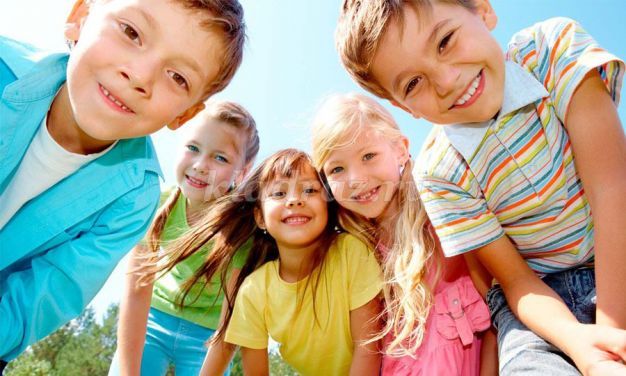
1. The topic of the “Club Hours”, the long-term thematic plan for K.Ch. for the six months .
2. Determine the frequency and duration of exercise training, usually once a week at the beginning of the program and 2-3 times a week thereafter. One of the main conditions for conducting a K.Ch. is its duration, namely at least 1 hour, because otherwise the children do not have time to develop their own life experience. 3. Determine the rules of behavior for children during the “Club Hour” 4. Develop organizational aspects for conducting the Club Hour. 5. Determine the order in which the Club Hour program begins. How many groups will participate in the first Club Hour, which groups, how to prepare children to the first K. Ch. Organization of club hour. All kindergarten employees are notified of the time and day of the event. During the Club Hour, the entrance doors to the garden are closed. Employees are at their workplaces and go about their daily business, waiting for the children to arrive. If possible, they communicate with the children, show them, tell them what they usually do here, and offer the children to help them. To achieve this, various activities are prepared in advance for visiting children. Teachers determine the signal for the end of the K.Ch., for example, the ringing of a bell, when the person in charge passes through all floors (groups), giving a sign to the children that it is time to return to their groups. They determine the order in which the K.Ch. program begins. How many groups will participate in the first K.Ch. ., which groups, how to prepare children for the first K.Ch.

Firstly, a discussion is organized “What is “Club Hour”, why is it needed, what will we do during K.H. and who would like to go to it? Secondly, we discuss what groups there are in kindergarten. The age of the children in these groups and what floor (wing) they are on. Thirdly, it is determined what kind of premises are available in the kindergarten. What are they called, who works there, what they do and what benefits they bring. Fourthly, a plan is given (a map of what happens where, if it is a “thematic” or “activity” K.Ch. Immediately before the first K.Ch. children discuss all the rules, they are briefly repeated before each K.Ch. Then instructions are given: "Children, you can move around the entire building for one hour, observing the rules of conduct. And at the ringing of the bell, you return to the group." After completing the K.Ch., all children participating, each in their own group, with a teacher, sit down in a circle on the carpet. A candle is lit, meditative music is turned on. A discussion begins. The teacher records the problems that arise in children in the process of CC and discusses them with children and parents (at a suitable time, finding ways to solve them in joint activities After each K.Ch. at the pedagogical council, educators, teachers and staff exchange opinions about: - what the children did when they came to its territory, what was special in the children’s behavior? - how the children who remained in their group reacted, when guests came to them (the question for teachers is whether the children followed the rules, and what prevented them from observing them, whether there were conflicts. — what tasks need to be solved at the upcoming competition
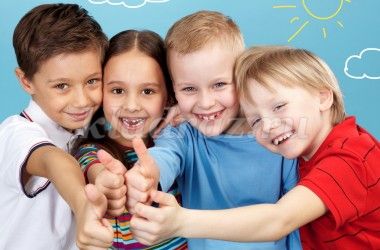
Conclusion In general, regular conduct of K.H. To summarize the above, it is important to note that with the help of such technologies, within the framework of socialization, the child’s idea of his immediate society is formed, that is, belonging to one or another group of people, etc.
We recommend watching:
Development of creative abilities of children of senior preschool age Sex education of senior preschoolers Written characteristics of the components of the subject-development environment in the teacher’s group Development of vocal and choral skills in senior preschoolers
Similar articles:
Children's aggression. What to do?
Independent activity of children in the younger group according to the Federal State Educational Standard during a walk
How to take into account the child’s temperament in the process of teaching activities
Methods for early teaching children mathematics
Maria Montessori's method of early childhood development

